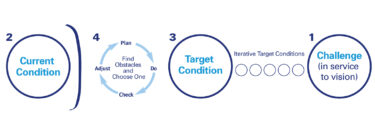Are you aware of whether each decision you make at the workplace is based on a fact, or on an assumption? I believe you would be amazed at how many fall into the latter category. In fact, do you even make a distinction between the two? Are we so used to reacting to a situation that assumption-based thinking is the new fact? I find it alarming when visiting organizations to discover high-level leadership down through the team member level being reactive due to a result driven environment. Simply stopping to confirm a thought is frowned upon as inappropriate behavior. Who condones this? Why is it perceived as acceptable leadership practices/skills?
So I would like to share an acronym with you to break these debilitating habits. I’m not sure if it warrants an official acronym label since its more of a questioning process but it may help you remember to think before you act and to question your decisions a little better. Let me share:
RATA (Results > Actions > Thinking > Assumptions)
To clarify:
What are our results that were produced by our daily actions that were driven by our thinking that were based on the assumptions we made?
So let’s breakdown this process down by using this (RATA) questioning sequence to understand how we may be doing business, or how we are “thinking” as an organization. When we talk about Lean for instance, I hear many different ideas from people as to what that means to them and their company. One of the first exercises I do in my sessions is to get a “finger on the pulse” as to how people understand or perceive Lean. I ask them to define it for me, and then we go around the room and share. I normally get all the “buzzy” words and ideas which is usually what I expect to hear. One key point that is usually absent is the integration of people, which starts my day one morning discussion because I recognize a gap already.
So if I’m a leader in an organization that is attempting to integrate Lean thinking within the current culture then I may need to begin by asking a few questions. What is Lean? Why are we trying to implement it? What problems are we having that Lean seems to be the countermeasure for? Lastly, how is it going for you? Or what is the status of your integration?
Here are some things one could ask that relate to RATA.
What are the results I’m getting? This can be a broad-scoped question as well as one dialed in to a specific process. A broad-scoped example could be related to the Hoshin or business plan. For example: How is our productivity in regard to customer demand? A more narrowly scoped question could be: what is the productivity for a specific machine that contributes upward to the larger productivity goals? Depending upon your specific level in the organization would determine which questions you may be asking, or it could be both.
Results are a good indicator of how we are doing, but I would like to differentiate between what you measure, and the results that themselves. I spend some time in my sessions discussing “leading versus lagging” indicators. A lagging indicator is historical in nature—something we are tracking that has already happened, such as a safety incident. A person has been hurt, we have to track it, but it’s after the fact. A leading indicator would be something process oriented that allows us to possibly prevent the incident, such as a near miss. Then we can examine what in the process allowed this to happen; it must be studied at the gemba (where the work is being done). My personal opinion is there should be a balanced scale of some type in regard to process and results (leading and lagging). If the scale is tipped heavily to the result side then we are more than likely a result-oriented company (manage by numbers). What I try to embed is that all results are affected by some type of process, so those are your leading indicators you must visualize and improve continuously.
When I then start to ask the questions about my results, and can assess what I’m measuring then I would ask, what actions are taking place on a daily basis that are producing these? Our actions as leaders are very important because they define how we are managing our specific scope or area; it also defines how our people view an abnormality when it occurs. First off, can they see it? Is it visible to them? Is there a known standard? These are ways to assess our actions that lead us to a particular thinking process that is either learned or considered what I hear often as “tribal knowledge”. How we answer the questions above could in turn tell us how reactive we are (fire hose), versus stopping to ask specific questions that lead us to a process that isn’t meeting expectations for internal or external customers and countermeasuring the situation.
If we can develop a discipline to assess our thinking that drives these actions then we can get to the root of an assumption versus a fact-based culture. I believe that this is one of the keys to success for Lean to take hold like a stake in the ground where people and process are the essence. I will admit that the majority of the practices I see out there are based highly on assumptions. This thinking is neither repeatable, nor sustainable and leads to symptom fighting most of the time unfortunately—back to the fire hose. It is my hope that we, as senseis in the lean community, can begin to use this questioning sequence that can change our thinking and actions which in turns improve the way we do business. It all starts with gemba visits and knowing how to get the facts.






